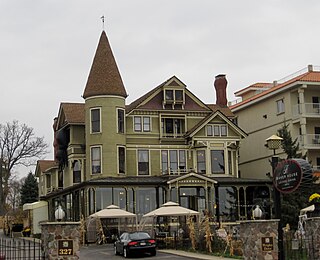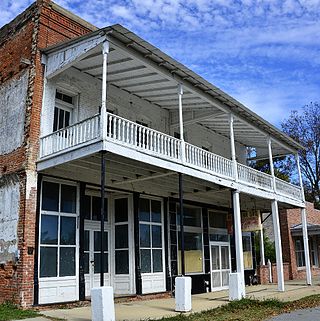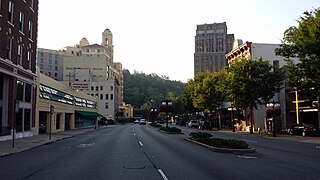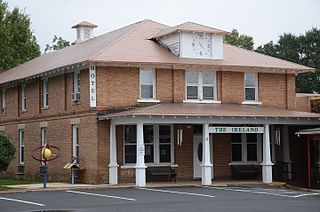
The Governor's Mansion Historic District is a historic district covering a large historic neighborhood of Little Rock, Arkansas. It was listed on the National Register of Historic Places in 1978 and its borders were increased in 1988 and again in 2002. The district is notable for the large number of well-preserved late 19th and early 20th-century houses, and includes a major cross-section of residential architecture designed by the noted Little Rock architect Charles L. Thompson. It is the oldest city neighborhood to retain its residential character.
The University of Arkansas Campus Historic District is a historic district that was listed on the National Register of Historic Places on September 23, 2009. The district covers the historic core of the University of Arkansas campus, including 25 buildings.

Redwood Cottage is a Queen Anne-styled mansion built in 1885 as a summer cottage in Lake Geneva, Wisconsin. Later it served as a sanitarium and later as a hotel. In 1984 the house was listed on the National Register of Historic Places.

The Arkansas City Commercial District encompasses the three oldest surviving commercial buildings in Arkansas City, Arkansas. They are located along Sprague (4th) Avenue, between Kate Adams (1st) Street and De Soto Avenue, and are a reminder of a once-thriving commercial district in the city. The Cotham Drug Store, a two-story brick building from c. 1900, stands near the corner of Sprague and De Soto, facing south. The Red Star Grocery, built 1900, stands to its right; it is also a two-story brick building, but its facade has been altered, replacing a recessed doorway with a flush one. Stylistically the two buildings are similar, with brick corbelling and a course of dentil molding, with a parapet above. The third building is the Ramus Brothers Market, which stands on Sprague Street, and was built in 1910 out of poured concrete.

The Johnson House and Mill is a group of historically significant structures at 3906 Johnson Mill Boulevard in Johnson, Arkansas, USA. The house is a two-story brick building, fashioned from locally manufactured bricks, and the mill is a large 2+1⁄2-story wood-frame structure with a gable roof and large waterwheel at one end. The mill was built c. 1865-67 and the house in 1882, by Jacob Q. Johnson, the town's namesake. The complex was listed on the National Register of Historic Places. The mill building, which operated well into the 20th century, has been converted into a hotel.
The Phoenix Hotel building at 180 Main Street is the most prominent and distinctive building in downtown Rison, Arkansas. It is a two-story brick building that was built in 1913 by Dr. T. H. Ackerman to replace a previous hotel building on the site. The most distinctive feature of its facade is a basket-handled arch that frames the recessed porch on the second floor. The roof line is more elaborate than that of other downtown buildings, with corbels and brick quoins decorating the roof edge. The hotel went through a modest number of owners before closing its doors in the 1960s.
The Monticello Commercial Historic District encompasses a portion of the historic business district of Monticello, the seat of Drew County, Arkansas. The district was listed on the National Register of Historic Places in 2011.
The Ridgeway Hotel Historic District encompasses three buildings located just east of the town square of Monticello, Arkansas. The centerpiece of the district is the Ridgeway Hotel, a five-story brick building built in 1930; it is the tallest, and one of the most elaborately decorated buildings in Monticello's central business district. The district also includes 202 East Gaines Street and the H.M. Wilson Building.

The Central Avenue Historic District is the historic economic center of Hot Springs, Arkansas, located directly across Central Avenue from Bathhouse Row. Built primarily between 1886 and 1930, the hotels, shops, restaurants and offices on Central Avenue have greatly benefited from the city's tourism related to the thermal waters thought to contain healing properties. Built in a variety of architectural styles, the majority of the buildings constituting the district are two- or three-story structures. The district was listed on the National Register of Historic Places in 1985, at which time forty contributing structures were identified; 101 Park Avenue was added in 2007, and a boundary decrease was approved in 2019.

The Conway Hotel is a historic hotel building at 108 Courthouse Square in Murfreesboro, Arkansas. Built in 1913, it was the first brick hotel building in the rural town; it was built in response to an influx of diamond miners into the area after the Crater of Diamonds was discovered. It is a two-story structure with modest Craftsman styling.

The Stuttgart Commercial Historic District encompasses a portion of the commercial center of Stuttgart, Arkansas. The district extends along Main Street between 1st and 6th Streets, and includes a few buildings on the adjacent numbered streets as well as Maple and College Streets, which parallel Main to the west and east, respectively. The majority of the district's 76 buildings were built between about 1900 and 1920, and are brick commercial structures one or two stories in height. Notable among these buildings are the Riceland Hotel, the Standard Ice Company Building, and the county courthouse.

The Hotel Seville is a historic hotel building at Vine and Ridge Streets in downtown Harrison, Arkansas. It is an L-shaped three story wood-frame structure, finished in brick and terra cotta veneer with distinctive Spanish Revival (Mission) styling. Its eastern entry porch is supported by polychrome terra cotta pillars, and portions of the exterior are finished in terra cotta tile with inset geometric patterns. Built in 1929, the building is one of the most elaborate examples of Spanish Revival architecture in the state. It was used as a hotel until the mid-1970s, when it was converted to elderly housing. It has since been converted back to a hotel.

The Siloam Springs Downtown Historic District encompasses the historic downtown area of Siloam Springs, Arkansas. The district is roughly bounded by University Street, Broadway, and Sager Creek, with a few buildings on adjacent streets outside this triangular area. This business district was developed mainly between about 1896, when the railroad arrived, and 1940, and contains a significant number of buildings dating to that period. It also includes Siloam Springs City Park, the location of the springs that gave the city its name. Notable buildings include the First National Bank building, a c. 1890 Romanesque Revival building, and the c. 1881 Lakeside Hotel, which is one of the city's oldest commercial buildings.

The Mountainaire Hotel Historic District encompasses a pair of former hotel buildings at 1100 Park Avenue in Hot Springs, Arkansas. They are virtually identical four story masonry structures, clad in a buff brick veneer, with stepped facades in an Art Moderne style. They were built about 1947, as part of a planned five-building complex, and are one a small number of Art Moderne buildings in the city. They were built by A.I. Albinson, originally from Minnesota, and operated as a hotel for about twenty years. They were thereafter converted to an elderly care facility. At the time they were listed on the National Register of Historic Places in 2004, the buildings stood vacant.

The Capital Hotel is a historic hotel at 111 West Markham Street in Little Rock, Arkansas. It is a four-story brick building with an elaborately decorated Victorian front facade. Its ground level window bays are articulated by Corinthian pilasters, and the tall second and third floor windows are set in round-arch openings with Ionic pilasters between. The fourth floor windows are set in segmented-arch openings with smaller Corinthian pilasters. The hotel was, when it opened in 1876, the grandest in the city, and the building is still a local landmark.

The Hot Springs Federal Courthouse is located at 100 Reserve Street in Hot Springs, Arkansas. It is a three-story building, with a steel frame clad in orange brick, with porcelain panels and aluminum-clad windows. It was designed by the Little Rock firm Wittenberg, Delony & Davidson, and was built in 1959–60 on the site of the Eastman Hotel, once one of the city's largest spa hotels. It is one of the city's best examples of commercial International architecture.

The former Castleberry Hotel is a historic commercial building at 61 Main Street in De Valls Bluff, Arkansas. It is a two-story masonry structure, built out of brick and capped by a hip roof whose eaves have exposed rafter tails. A porch extends across the sidewalk in front of the building, supported by brick piers. Built in 1925, it is a good local example of Craftsman architecture. It was the town's principal hotel, serving through travelers until the 1960s, when the town was bypassed by interstate highways.

The Russellville Downtown Historic District encompasses an eight-block area of downtown Russellville, Arkansas. This area, developed primarily between 1875 and 1930, includes the city's highest concentration of period commercial architecture, a total of 34 buildings. Most of them are brick, one or two stories in height, and in a variety of styles. The district is roughly bounded by Arkansas and West 2nd Streets, El Paso Avenue, and the Missouri-Pacific Railroad tracks.

The Grand Auditorium and Hotel Block is a group of four adjoining historic commercial buildings located in Story City, Iowa, United States. From the east, buildings one and three housed various commercial establishments over the years. Building two housed the Grand Opera House, now known as the Story Theatre/Grand Opera House. It has been used for both live theater productions and movies. The fourth building housed the Grand Hotel. The Grand Hotel and Auditorium Company was organized from Story City's Commercial Club in 1913. They hired Estherville, Iowa architect James S. Cox to design the complex, which was completed in December 1913. While each facade is unique, all four buildings share common elements. Their commonalities include two stories in height, red-brick exterior walls ornamented with buff brick and concrete details. The first three buildings share the same wall plane, while the hotel is slightly recessed from the others. They also decrease in scale from east to west. This slight variation is due to differing treatments of the cornices and parapets. The buildings were listed on the National Register of Historic Places in 1980.

The Aristocrat Motor Inn is a historic hotel building at 240 Central Avenue in Hot Springs, Arkansas. It is a large seven-story structure, with a six-story U-shaped tower set on a basically rectangular ground floor. It is finished in glass, brick, and metal, in the Mid-Century Modern style. The tower is organized around a central courtyard, with the interior facades in a sawtooth pattern to maximize light coming into the hotel rooms facing inward. The hotel was built in 1963 by Samuel Kirsch, a local businessman engaged in a variety of pursuits. It was one of the first hotels built along the city's Central Avenue to feature a Modernist exterior. It was operated as a hotel until 1978, and was after converted into low-income housing.


















